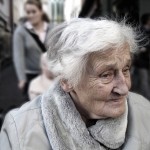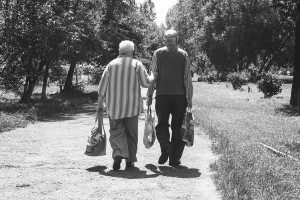
Quality of life (QoL) research in dementia has attracted a myriad of studies over the past decades. After all, without an existing cure yet, we want to ensure that people with dementia can live well for as long as possible (Rahman, 2015). Indeed, it is a governmental objective to do so (DH, 2015).
Some research for example shows that QoL is similar in people with dementia living in a care home to those living in the community (Beerens et al., 2014). Other research shows that QoL is linked to engaging in social activities, such as singing groups or individualised social activities (DiNapoli et al., 2016; Giebel et al., 2014). Another strand of research investigates how the ability to perform daily activities, such as continence and dressing, are associated with QoL. In a recent analysis of a UK dataset for example, we showed that ADL (Activities of Daily Living) Total significantly predicted QoL in moderate dementia, and in the overall sample of people with mild, moderate, and severe dementia (Giebel et al., 2015).
Understanding how individual ADLs contribute to QoL may help develop targeted interventions to improve those ADLs linked to the greatest reductions in QoL.
Considering the large number of studies on QoL in dementia, it isn’t surprising to find a big variety of different scales that measure QoL. To find out more, take a look at one of my old Social Care Elf blogs on a systematic review of QoL measures in care homes).
To pick up on the relationship between everyday activity performance and QoL, Barbe et al. (2016) have investigated this issue in people with Alzheimer disease in France and Switzerland. I am going to look at this study in today’s blog.

The study asked people with Alzheimer disease which activities were most important to them for quality of life.
Methods
People were deemed eligible for the study if they had a diagnosis of Alzheimer disease; were in the mild to moderate stages of the condition, and were 65 years or older. Participants were recruited from seven hospitals across France and Switzerland. Each participant had a main informal carer who also took part in the study.
Participants were asked to complete the Dementia Quality of Life (DQoL) scale, which measures health-related QoL. It contains the five domains of ‘self-esteem’, ‘positive affect’, ‘negative affect’, ‘feelings of belonging’, and ‘sense of esthetics’.
Participants (it is unclear whether the person with dementia or the carer) also completed two measures on the ability to perform everyday tasks, including the original Katz ADL scale with tasks such as dressing and feeding, and the shortened Lawton and Brody IADL scale, including using the telphone, shopping, medication management, and transportation. Data were also collected on depressive symptomatology (Cornell Scale for Depression in Dementia) and behavioural problems (Neuropsychiatric Inventiory), as well as general cognition (Mini-Mental State Examination) and caregiver burden (Zarit Burden scale).
Results
In total, 123 people with dementia and their carers participated in the study. The number of people in the mild and moderate stages was similar. Two ADLs and one IADL were found to be significantly associated with health-related QoL in people with Alzheimer disease. In particular, transferring out of a chair or bed and using the telephone were related to improved self-esteem. Getting dressed without assistance was linked to lower negative affect.
The authors also explored how other factors might contribute to health-related QoL. They found that depression was associated reduced self-esteem and reduced negative affect. Moreover, anxiety as a behavioural problem was found to be associated with lower self-esteem, positive affect, and negative affect.

Being able to use the phone and transfer out of a chair were both associated with better quality of life.
Limitations
It is a limitation of the study that it is not mentioned who completed the IADL and ADL scale, the DQoL, the NPI, and the CSDD. In many studies, carers complete these measures. It is important to know who in fact provided the information, as there may be some variation.
Also, I know that the Lawton & Brody scale is THE go to scale to measure complex IADLs. But since its publication in 1969, so much has changed, and so many novel activities are present in our daily lives. Take playing candy crush on your IPad for example, or messaging someone on What’s app on your phone. A limitation of this study might thus be the limited daily activity assessment, and reliance on an old IADL scale, which only includes eight activities.
Recently, new scales have been developed to account for novel activities and be more inclusive, such as the Amsterdam IADL scale (Sikkes et al., 2013) and the revised Interview for Deteriorations in Daily Living Activities in Dementia (R-IDDD) (Giebel et al., 2014).

Some of the outcome measures commonly used in this type of study may be out of date.
Summary
With so much work focusing on global ADL and IADL scores across clinical trials and observational and questionnaire-based studies, it is refreshing, and much needed, to see research focusing on individual daily activities. Indeed, being able to transfer yourself out of a chair is a completely different aspect than being incontinent or having difficulties eating.
Findings from this study highlight that well-being is not equally associated with all types of daily activities. Hence, in order to help people with dementia live well for longer, those activities affecting QoL need to be focused on to a greater extent than others.
Links
Primary paper
Barbe, C., Morrone, I., Wolak-Thierr, A., Dramé, M., Jolly, D., Novella, J.L., & Mahmoudi, R. (2016). Impact of functional alterations on quality of life in patients with Alzheimer’s disease. Aging & Mental Health, DOI: 10.1080/13607863.2015.1132674
Other references
Beerens, H.C., Sutcliffe, C.S., et al. (2014). Quality of Life and Quality of Care for People With Dementia Receiving Long Term Institutional Care or Professional Home Care: The European RightTimeplaceCare Study. JAMDA, 15(1), 54-61. [PubMed abstract]
Department of Health (2015). Prime Minister’s challenge on dementia 2020. London: Department of Health.
DiNapoli, E., Scogin, F., Bryant, A., Sebastian, S., & Mundy, M. (2016). Effect of individualized social activities on quality of life among older adults with mild to moderate cognitive impairment in a geriatric psychiatry facility. Aging & Mental Health, 20(03), 262-270. [PubMed abstract]
Giebel, C.M., Challis, D., & Montaldi, D. (2014). A revised Interview for Deterioration in Daily Activities in Dementia (R-IDDD) reveals the relationship between social activities and well-being. Dementia, DOI:10.1177/1471301214553614
Giebel, C.M., Sutcliffe, C., & Challis, D. (2015). Activities of daily living and quality of life across different stages of dementia: a UK study. Aging Ment Health, 19(1), 63-71. DOI:10.1080/13607863.2014.915920. [PubMed abstract]
Rahman, S. (2015). Living Better with Dementia: The Importance of the Person and the Environment for Wellbeing. London: Jessica Kingsley Publishers.
Sikkes S.A.M., Knol D.L., Pijnenburg Y.A.L., de Lange-de Klerk E.S.M., Uitdehaag B.M.J., Scheltens P (2013). Validation of the Amsterdam IADL Questionnaire©, a New Tool to Measure Instrumental Activities of Daily Living in Dementia. Neuroepidemiology, 41, 35-41. [PubMed abstract]
Photo credits
Images Money on Flickr, CC BY 2.0
Alberto G on Flickr, CC BY 2.0

Yeha- my new @SocialCareElf blog! Impact of functional alterations on QoL in #Alzheimer disease https://t.co/fXyYQ9ORue #demphd #alzchat
My new @SocialCareElf blog :) Impact of functional alterations on QoL in Alzheimer https://t.co/fXyYQ9ORue @SNMSWResearch @LEAD_Coalition
Keeping up with research in my #PhD area by writing for @SocialCareElf – ADLs &QoL in Alzheimer https://t.co/fXyYQ9ORue @dr_shibley #phdchat
@ClarissaGiebel @SocialCareElf well done Clarissa. you’ve done a superb PhD. any news on your viva date yet?
@dr_shibley @SocialCareElf thx!My sups moved the date to around autumn,I’m aiming 4 September.Will set official date in a couple of months!
@dr_shibley @SocialCareElf currently working like a maniac on entering the rest of my data(thx to @Angela_Aldridge &others)+analysing rest
@ClarissaGiebel @SocialCareElf @Angela_Aldridge yes remember the cardinal rule not to start big projects as you’re winding up a PhD
@dr_shibley @SocialCareElf @Angela_Aldridge no, I’m not, just wanting to produce a really good thesis with little to criticise ;-)
@ClarissaGiebel @SocialCareElf @Angela_Aldridge yes, I had no corrections (showing off) – but was a junior doctor doing 100 hrs/wk then too.
@dr_shibley @SocialCareElf plus one of my chapters got back with major revisions -need to work that up to an accept! #demphd #phdchat
@ClarissaGiebel @SocialCareElf great when you submit it finally
New @SocialCareElf blog by #pssru staff: Impact of functional alterations on quality of life in #Alzheimers https://t.co/sKC7jQ2d7v
What functional alterations have the most impact on quality of life in Alzheimer’s? @ClarissaGiebel https://t.co/9fWQOAOKlP
Using the phone and transferring from bed/chair had the most impact on quality of life in Alzheimer’s@ClarissaGiebel https://t.co/9fWQOAOKlP
Impact of functional alterations on quality of life in Alzheimer disease https://t.co/H0zAy2dDE1 via @sharethis
Emily Stewart look what just came up on my newsfeed! After we were just talking about it
What a coincidence haha, can’t wait for it to be over xx
Do we need to update how we measure ADLs in the light of novel activities? @ClarissaGiebel https://t.co/9fWQOAOKlP
Alzheimer’s patients: well-being is not equally associated with all types of daily activity @ClarissaGiebel https://t.co/9fWQOAOKlP
Impact of functional alterations on quality of life in Alzheimer disease https://t.co/0HWv4gClIm via @sharethis
Impact of functional alterations on quality of life in #Alzheimers disease https://t.co/81TCHRzkpL #QoL #dementia #caregiving #geriatrics
How do individual daily activities contribute to well-being in #dementia? New @SocialCareElf blog https://t.co/fXyYQ9ORue @SCIE_socialcare
Great way to engage with the public – writing a @SocialCareElf blog :) #dementia #dailyactivities #QoL https://t.co/fXyYQ9ORue #demphd